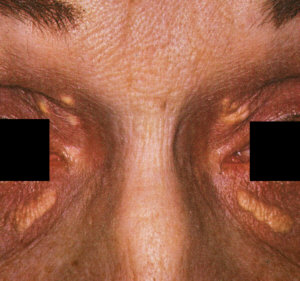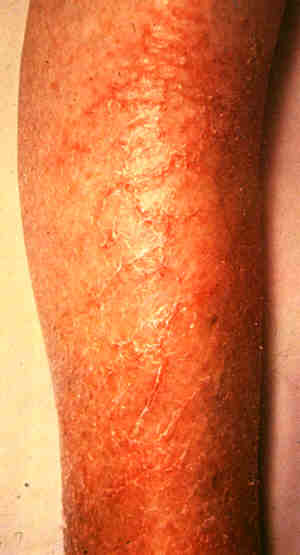|
X
Xanthelasma
palpebrum |
Xerosis
XANTHELASMA PALPEBRUM
Xanthoma is the medical
term fat deposits in the skin and the most common type is xanthelasma
palpebrum which usually occurs on or near the eyelids.
- Cause
- Inherited disorder
of fat metabolism. This form usually affects children or young
adults and runs in the family.
- Increased fats in
the blood.
- Idiopathic (of unknown
cause).
Symptoms
- Soft yellow slightly
plaques (raised patches) on the inner upper eyelids and occasionally,
the lower lids as well.
 |
Xanthelasma.
Click
on image for larger view |
Complications
- Heart disease if fat
levels are increased in the blood.
-
- What you can do
- You should consult
a doctor.
-
- What the doctor
may do
- Measure the blood
lipids (fats) and prescribe lipid lowering agents, if they are
elevated.
- Treat xanthelasma
palpebrum with the carbon
dioxide laser or trichloroacetic acid.
- TOP
XEROSIS
Xerosis, dry skin or
chapped skin is a common problem in the elderly but can also
affect younger individuals and children.
- Cause
- Dehydration of the
outer layer of the skin due to:
-
- Low humidity, for
example, in winter and under air-conditioning.
- Excessive use of harsh
soaps.
- Inheritance (see ichthyosis).
- Taking of diuretics
(drugs used to remove water from the body).
-
- Symptoms
- Dry skin with fine
scaling, usually most prominent on the legs.
- Generalised itching.
-
- Complications
- Xerotic eczema may develop when the skin
is so dry that it cracks and becomes inflamed.
- Nummular
dermatitis or discoid eczema has
a tendency to develop in areas of xerosis.
 |
Xerotic eczema.
Click
on image for larger view |
- What you can do
- Take antihistamines
to relieve itching.
- Add moisture to the
air - leave containers with water by radiators and air conditioning
vents.
- Take shorter and less
frequent baths.
- Apply moisturisers
regularly or use bath oils.
- Consult a doctor.
-
- What the doctor
may do
- Exclude underlying
causes.
- Prescribe topical
steroids if complicated
by xerotic eczema or nummular
dermatitis .
- TOP
|

